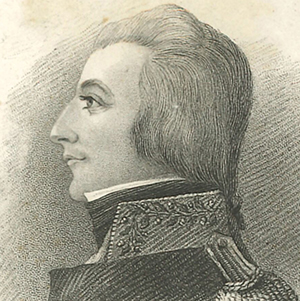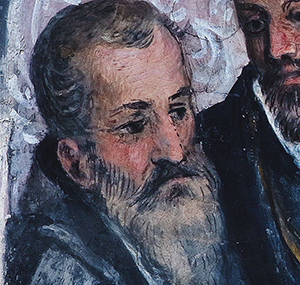ON THIS DAY
Published in Issue 4 (July/August 2021), News, Volume 29BY AODHÁN CREALEY
JULY
11/1792

Above: Theobald Wolfe Tone—dropped
in on the final day of the Belfast Harp
Festival but was not impressed: ‘The
harpers again. Strum, strum and be
hanged.’
The Belfast Harp Festival, a three-day event, opened in the Exchange Rooms. Perhaps the first attempt in Ireland to actively rejuvenate Gaelic culture occurred in Presbyterian Belfast, then known as the ‘Athens of the North’, a century before the Irish Literary Revival. Organised by a committee chaired by Dr James MacDonnell, a lover of Irish music from the Glens of Antrim, and which included Henry Joy (1754–1835), editor of the Belfast News-Letter and uncle of Henry Joy McCracken, and Thomas Russell, the ‘man from God knows where’, its aim was ‘to revive and perpetuate the Ancient Music and Poetry of Ireland’. Ten traditional Irish harpers (including one woman) and a Welshman were brought together to compete for prizes. They ranged in age from 97-year-old Denis Hempson from Magilligan, Co. Derry, who played the harp in the old style of plucking with the fingernails, to fifteen-year-old William Carr from County Armagh. Six of them, including Hempson, were blind. First prize went to Charles Fanning from County Cavan and second to Arthur O’Neill from County Tyrone, though they were all given a payment. Significantly, the committee had commissioned the nineteen-year-old Edward Bunting to write down the music as it was being played, which he duly did, along with a mine of information about the harpers themselves and harp lore. His collection, arranged for piano, was subsequently published in three volumes, notably The ancient music of Ireland (1840). No doubt many United Irishmen—the society had been founded in the nearby Peggy Barclay’s tavern nine months earlier—were impressed by the event, but not so Theobald Wolfe Tone. Dropping in on the final day, he famously wrote in his diary: ‘The harpers again. Strum, strum and be hanged.’
07/1981
Donal Foley (59), deputy editor of the Irish Times, best known for his satirical column ‘Man Bites Dog’, died.
09/1921
The IRA ambushed an RIC/USC patrol in Raglan Street, West Belfast, killing one RIC officer. During a cycle of sectarian violence over the following 24 hours, some 22 lives were lost, including thirteen Catholic civilians and six Protestant civilians.
10/1921
On the eve of the Truce, four off-duty British soldiers, including two from the South Staffordshire Regiment, which had been involved in several reprisal killings in the preceding weeks, were spotted by the IRA, arrested and executed without the sanction of a senior IRA officer, in Ellis Quarry, Cork.
11/1921
The Truce in the War of Independence came into effect. Since January that year well over 1,000 lives had been lost in the conflict, including 61 lives over the four days since the truce was announced.
13/2011
The Cloyne Report, investigating allegations against eighteen priests in the diocese of Cloyne between 1996 and 2009, was published. It found that Bishop John Magee had ignored church guidelines requiring all suspected molestation cases to be reported to Gardaí. It also found that the Vatican had encouraged the concealment.
20/2011
‘The Cloyne Report excavates the dysfunction, disconnection, elitism—the narcissism—that dominate the culture of the Vatican to this day. The rape and torture of children were downplayed or “managed” to uphold instead the primacy of the institution, its power, standing and “reputation”’—Taoiseach Enda Kenny, speaking at the opening of a debate on the Cloyne Report in Dáil Éireann.
AUGUST
14/1598

Above: Hugh O’Neill, Earl of Tyrone—
inflicted the heaviest defeat ever suffered by the English in Ireland at the Battle of the Yellow Ford.
The Battle of the Yellow Ford. Hugh O’Neill, Earl of Tyrone, along with his Ulster allies and some Spanish, inflicted the heaviest defeat ever suffered by the English in Ireland. Early that morning Sir Henry Bagenal, marshal of the queen’s army in Ireland, set out from Armagh with 300 cavalry and c. 4,000 foot-soldiers to relieve the starving garrison of 150 men at Portmore Fort, some five miles away. But O’Neill was well prepared. Using an elaborate series of carefully constructed earthworksto block Bagenal’s path and concealing his men in the thick woods on either side, he subjected the English to a constant barrage of deadly fire. Bagenal himself, riding in the vanguard, fell early, shot in the head when he lifted his visor to catch his breath. To add to their woes, their best cannon became stuck in the mud and their powder accidentally detonated. Forced to retreat, the remainder of Bagenal’s army was dispersed by the Irish cavalry and harried by O’Neill’s pikemen and sabremen. In all, the English lost up to 2,500 men, including eighteen captains, and a mere 1,500 managed to make it back to Armagh. O’Neill lost c. 300 men. O’Neill could have pursued them all the way to Dublin, but he hesitated. It was one thing to trounce an ill-prepared English army on his own patch. Further action, however, would require a firmer commitment from Spain. Instead, he made strict terms. Having surrendered all of their arms and ammunition, the remnants of Bagenal’s army were given safe passage to Newry, where they boarded ships to take them to Dublin. Portmore Fort was abandoned.
09/1971
Internment was introduced by the Stormont government with the arrest of 342 men, of whom 226 were detained. Thirteen lives were lost that day during widespread violence, particularly in West and North Belfast.
11/1971
John McKerr (49), a father of two, was shot dead in Ballymurphy, West Belfast, the last of eleven unarmed civilians with no paramilitary affiliations killed by the British Parachute Regiment in that area over a three-day period.
12/1971
With over 4,000 refugees from Northern Ireland in refugee camps in the Republic, Taoiseach Jack Lynch called for the abolition of Stormont.
16/1921
Sinn Féin members who were returned in the election to the parliament of Southern Ireland under the terms of the Government of Ireland Act constituted themselves as the Second Dáil Éireann.
25/1971
A 15lb. Provisional IRA bomb exploded at the Electricity Board of Northern Ireland’s offices in Belfast’, killing Harry Beggs (23), a close schoolfriend of Peter Robinson, later first minister of Northern Ireland (2008–16), and injuring 35 others. Robinson disclosed years later that it was Beggs’s death that prompted him to enter politics.
29/1871
Jack Butler Yeats, illustrator and painter, born in London, the youngest child of the portraitist John Butler Yeats and brother of W.B. Yeats.
30/1951
Rosemary Scanlon, a singer known as ‘Dana’, broadcaster in the US with the conservative Catholic television channel EWTN and independent MEP for Connacht-Ulster (1999–2004), who made two bids for the Irish presidency, born in London.
31/1971
Clifford Loring (18) of the Royal Artillery Regiment was shot dead by an IRA sniper whilst on checkpoint duty in West Belfast, the 35th death since the introduction of internment that month.
















